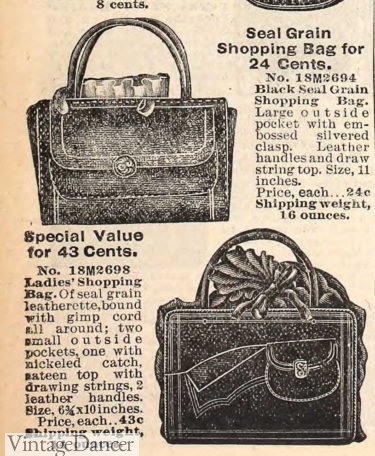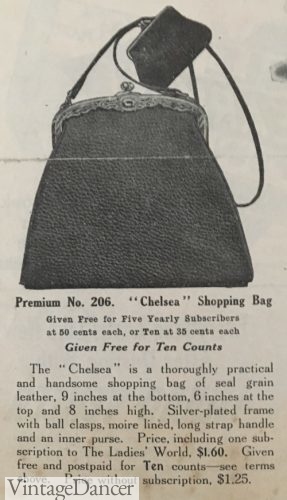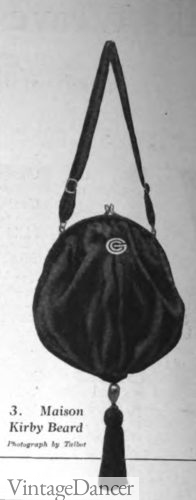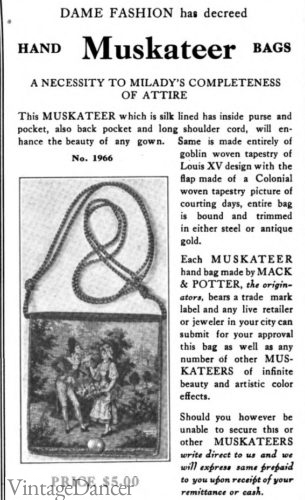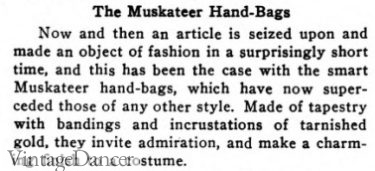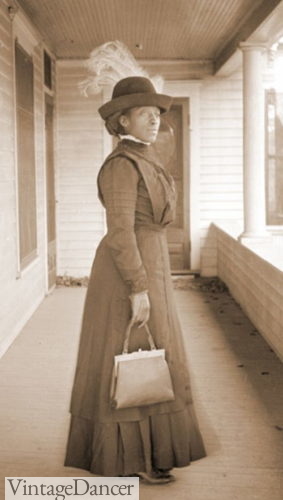
John Johnson, photographer, captured this woman with her purse
The first bags to be called ladies’ hand-bags appeared in the late Victorian and Edwardian eras, 1900 -1910s. Designs came from leather good trades rather than fashion houses. Vuitton, Gucci (est 1906), Prada (est 1913), and Hermes (est 1837) each started out as saddle, luggage, and harness manufacturers. Hermes gradually began to use more “exquisite leathers” such as alligator, ostrich, and crocodile in handbag designs, elevating the bag into the fashion space.
After the turn of the century, leather could be dyed in rich colors like red, green, or purple, but most were black or brown. Bags also shrank down further at this time.
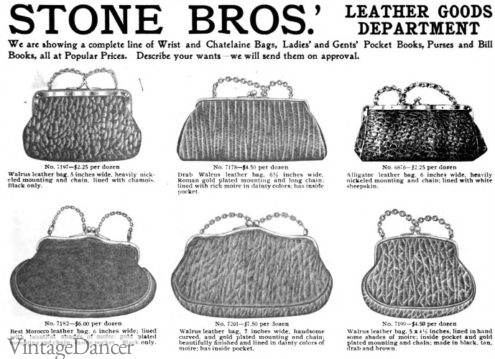
1903 crocodile leather chain handle bags
Narrowing skirts of the Edwardian era meant there was no room for hidden pockets in skirts. This upset many feminist American women who pointed out that while men had an ample number of pockets in their suits and coats, women were required to give up one useful hand so they could carry a purse!
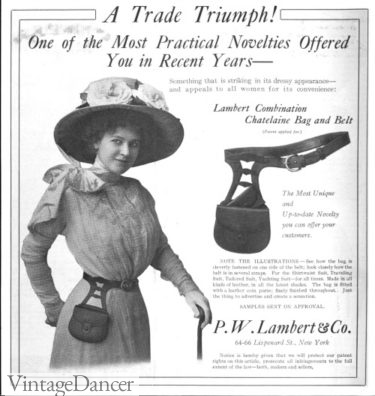
1909 – A Belt and Chatelaine Bag for the New Edwardian Woman on the Go
This didn’t stop women from using handheld and chatelaine bags, but it did encourage women to turn to more practical and masculine designs. Small leather bags with a wrist strap complimented walking suits of the Edwardian lady.
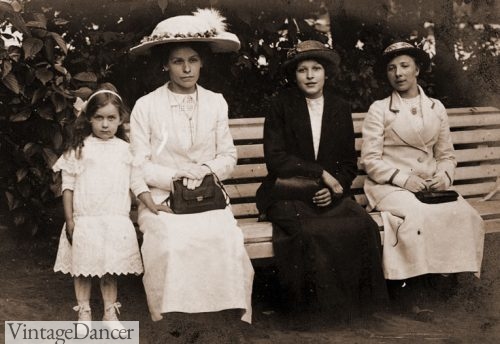
Edwardian Ladies Holding Leather Purses
In the 1890s, a favorite leather was green or maroon morocco leather. The use of crocodile, lizard, seal, goat, elephant, and faux reptile skins were also very popular during this era. They gave the purse a distinct texture, large or small, and an overall richness.
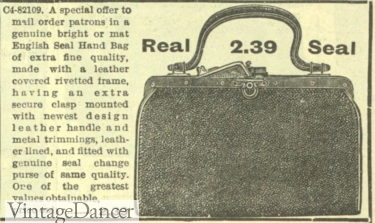
1907 Seal Skin Purse
Depending on their purpose, they were fitted with internal pockets for a mirror, scent bottle, cards, glasses, and hanky. Separate coin purses, mirrors, and billfolds were also sold in matching set.
A few fancy leather bags featured embossed, burned or handprinted florals to add a bit of color.

1909 Handbags with Matching Coin Purses and Mirrors
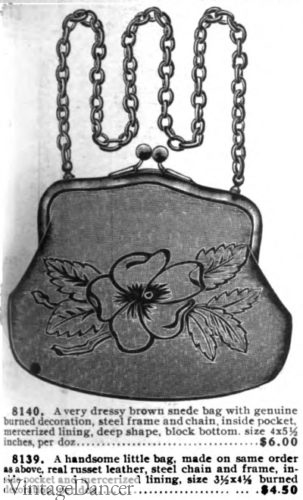
1903 Burned Leather Purse
Shopping bags were usually larger and void of these compartments, leaving more room for purchased goods. A large shopping bag was about 6-11 inches wide and tall. Hardly big enough for today!
- 1901 Shopping Bags with Expandable Inner Bag
- Edwardian Leather Frame Handbag with Coin Purse

1913 Leather Shopping Bag
City women had department stores to thank for the necessity of larger shopping bags. Not only did they sell them, but they gave women a reason to leave the house for most of the day. Department stores like Macy’s in New York and Selfridges in London were social gathering places — not just for shopping, but for dining, taking tea, and attending events.
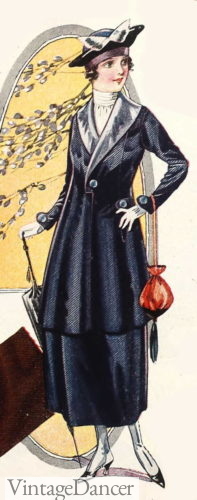
1918 Pretty Reticule Purse
As WWI began, the small bag was once again replaced by a larger, practical, leather or faux leather shopping bag. Pleated tops allowed rounded shapes to become fashionable and lady-like. They came with either one wrist strap or two handles.
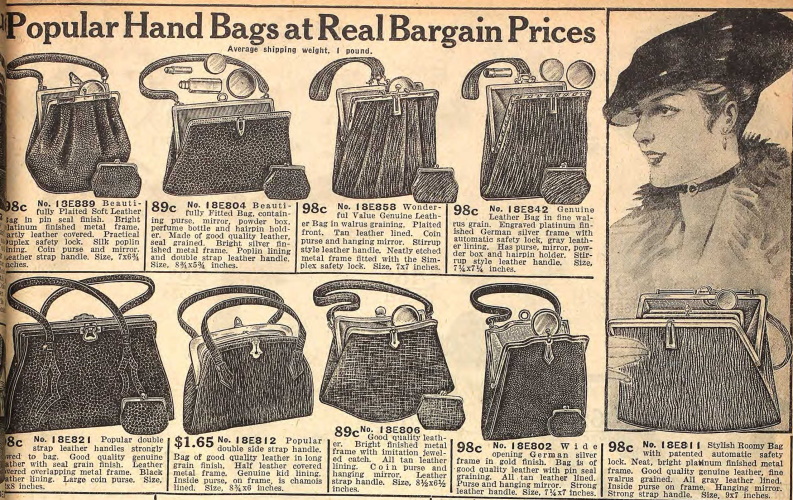
1916 Leather Bags
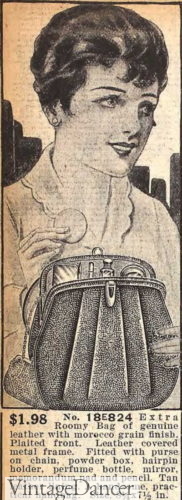
1916 Pleated Leather Bag with Twist Lock
Sturdy black fabrics such as heavy poplin were cheaper and washable. They were sometimes sold in bold plaids and prints, which did a better job of hiding dirt.
Coins and Billfolds
Besides handbags, coin purses, wallets, money bags, card cases, notepads, and billfolds could be carried alone or in a larger bag. Large billfolds became “clutch” style combination purses.
After 1910, as women embraced their personal care outside of the home, purses were sold with combs, brushes, nail files, and mirrors.
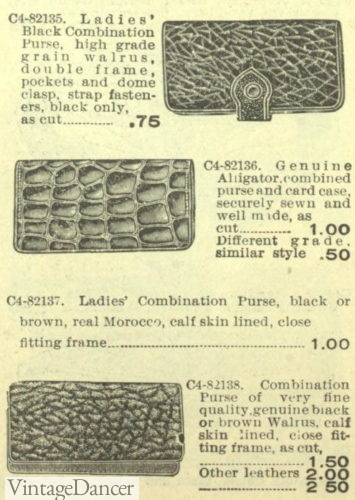
1907 Billfold Combination Purses
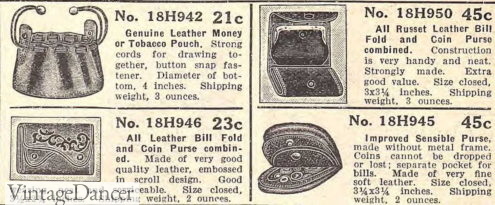
1912 Tobacco or Money Bag, Billfold Wallets, and Coin Purse
Small Bags
The chain handle purse with kiss lock and metal frame emerged around 1903. It was much prettier than the luggage style handbags.
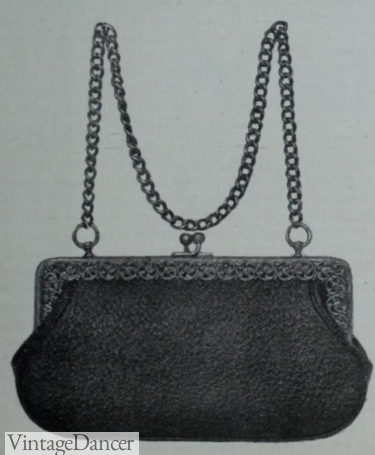
1903 Chain Handle Leather Purse
The leather handbag was considered too utilitarian for the many women. Fashionable women sought out delicately embroidered bags or metal mesh purses and chatelaines. These were no more than 5 inches wide, usually less.

1915 Small Frame Purse
Chatelaines’ clipped to a belt or skirt waistband, whereas purses were hand carried.

1902 Metal Mesh Chatelaine Bags
German chain metal mesh bags were highly collectable back then — and now. They could have frame tops, gate tops, kiss locks, or twist locks.
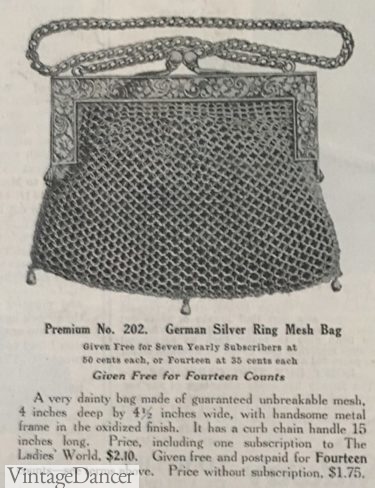
“German Metal Ring Mesh Bag”
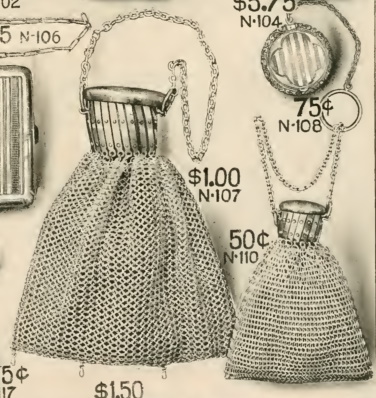
1914 “Gate” Top Metal Bags
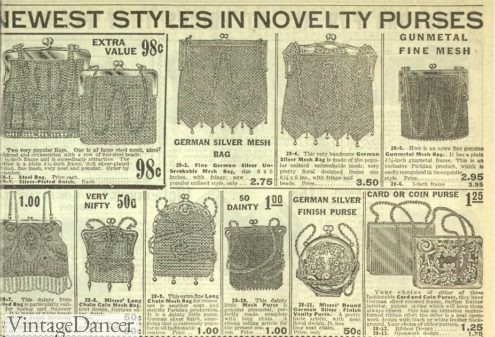
1913 Mesh Bags
The reticule shaped bag remained as popular as they were in the Victorian era. They held fragile things, like opera glasses and other evening accessories. They could easily be handmade and elaborately decorated with beads and applique. They were more pretty than useful, although women decorated larger bags for home use — such as storing knitting supplies, lingerie, and slippers.
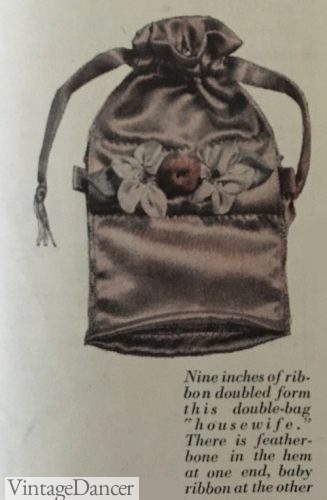
1914 Simple Reticule Bag
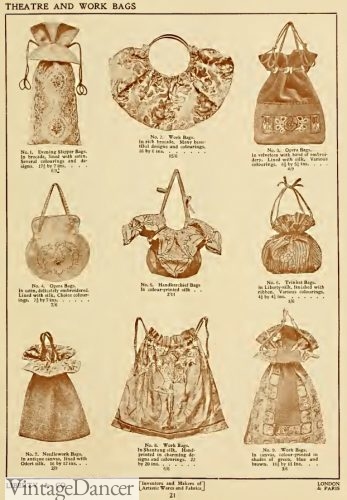
1911 Opera, Dance, and Specialty Evening Bags
The reticule adapted into new forms after the turn of the century. The Dorothy bag was made of soft materials and a drawstring top. It was often covered in beads and included a tassel bottom lined with silk, cotton, or velvet with a long cord or ribbon handle that hung at knee level. Some were decorated with steel beads instead of glass beads.

1918 Pretty Reticule Purse
It was the velvet bag which crossed the lines from day to night. Rounded body with a long handle and even longer tassel on the bottom, it echoed the longer lines of the post-1910 silhouette.
- 1914 Velver Tasseled Bag
- 1913 Walking Bags and Traditional Reticule
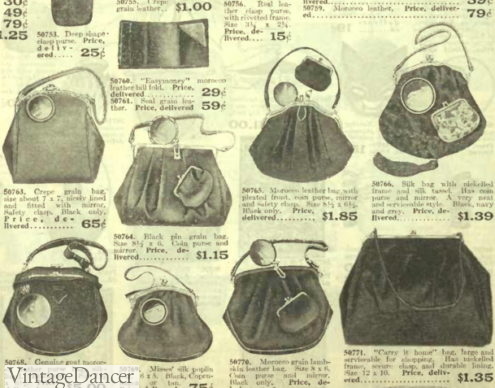
1918 Velvet, Fabric, and Leather Bags with Mirrors
The small beaded handbag was a thing of beauty in the 1910s. Designs were scrollwork, florals, geometric patterns, and fruit. Gold beads on jet black, steel, or white ground are featured here:
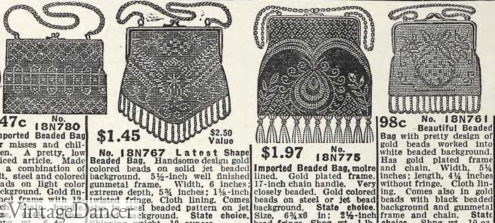
1913 Beaded Purses
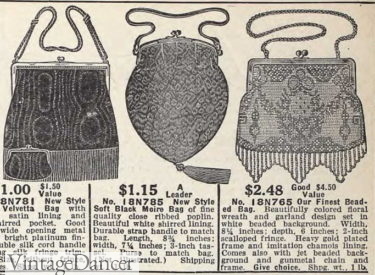
1913 Velvet, Moiré, and Beaded Purses
The tapestry bag was another fad, often featuring scenes from the three Musketeers or other romantic “old” scenes.
- 1912 Musketeer Bag
- 1912 Musketeer Bag Description
- 1912 Tapestry Bag
Asian imported tapestry bags such as the Japanese Netsuke (Nituski) used embroidered silk to embellish purses. Tapestry bags were made from Persian brocade an other Asian fabrics too.
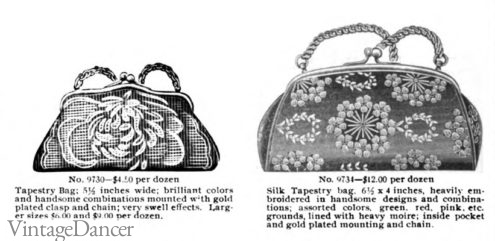
1903 Tapestry Bags
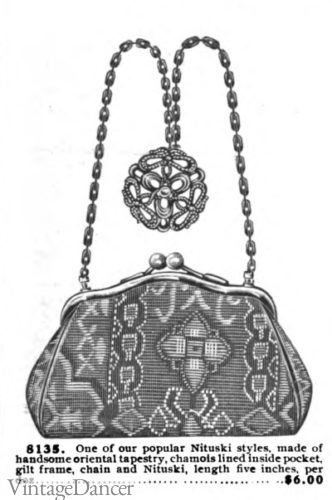
1903 Nituski Tapestry Bag
The small tapestry bag was similar to the very large carpet bag, which was a Victorian era holdover. They were used for traveling luggage. The fabric was the same “tapestry” found on beautiful living room hanging wall tapestries. You may remember Mary Poppins arriving with her Carpet Bag in tow.
Carpet bags were out of style in the 1900s. Instead, Club bags or Oxford bags (similar to a Gladstone bag) were used for traveling by women and men.
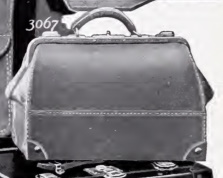
1914 Travel Bag
Edwardian Bags Today
The Victorian- Edwardian leather purse is the most difficult of the purse styles to obtain today, although there has been a small revival for them recently. Evening bags and dressy reticules with embroidery, tapestry, beading, and metal mesh are much easier to find. However, locating one big enough to hold a cell phone is the real challenge.
Shop new Edwardian styles purses and bags here
Search for genuine vintage Edwardian era purses.
Debbie Sessions has been teaching fashion history and helping people dress for vintage themed events since 2009. She has turned a hobby into VintageDancer.com with hundreds of well researched articles and hand picked links to vintage inspired clothing online. She aims to make dressing accurately (or not) an affordable option for all. Oh, and she dances too.
